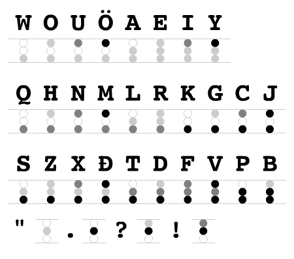Tag: Visual edit |
No edit summary Tag: Visual edit |
||
| (13 intermediate revisions by 9 users not shown) | |||
| Line 1: | Line 1: | ||
| − | Vötgil is |
+ | Vötgil is a language made by Jack Eisenmann in 2012. The syntax and word list were derived from [[Pegakibo]]. Vötgil has an simple, oligoanalytic grammar and just 600 words. |
==Alphabet and Phonology== |
==Alphabet and Phonology== |
||
[[File:Letters.png|thumb|294px|right|The Vötgil alphabet.]] |
[[File:Letters.png|thumb|294px|right|The Vötgil alphabet.]] |
||
| − | Every word in Vötgil has exactly three letters. The first letter is always a consonant. The second or third letter must be a vowel. The letters W, |
+ | Every word in Vötgil has exactly three letters. The first letter is always a consonant. The second or third letter must be a vowel. The letters W, Y, and R may act as both vowels and consonants. |
The alphabet and pronunciation are shown in the tables below. |
The alphabet and pronunciation are shown in the tables below. |
||
| Line 90: | Line 90: | ||
==Grammar== |
==Grammar== |
||
| − | Vötgil has |
+ | Vötgil has 4 parts of speech |
*Noun |
*Noun |
||
*Verb |
*Verb |
||
*Descriptor |
*Descriptor |
||
| + | *Preposition |
||
| − | *Functionals |
||
Word order is SVO. Verbs are always transitive. |
Word order is SVO. Verbs are always transitive. |
||
Descriptors behave as both adjectives and adverbs. A descriptor is placed before the word which it modifies. |
Descriptors behave as both adjectives and adverbs. A descriptor is placed before the word which it modifies. |
||
| − | + | Prepositions encompass both conjunctions and traditional English prepositions. |
|
Two nouns may be placed adjacent to each other as in English. Under these circumstances, the construction is interpreted as "(second noun) of or pertaining to (first noun)". |
Two nouns may be placed adjacent to each other as in English. Under these circumstances, the construction is interpreted as "(second noun) of or pertaining to (first noun)". |
||
| Line 112: | Line 112: | ||
A clause may be surrounded by quotation marks and embedded in another clause. The embedded construction behaves as a noun representing the action of the subclause. For this reason, such a grouping is called a "situation noun". |
A clause may be surrounded by quotation marks and embedded in another clause. The embedded construction behaves as a noun representing the action of the subclause. For this reason, such a grouping is called a "situation noun". |
||
| − | Counting is in base ten with the most significant digit on the |
+ | Counting is in base ten with the most significant digit on the left side. |
==Examples== |
==Examples== |
||
Revision as of 16:04, 31 March 2020
Vötgil is a language made by Jack Eisenmann in 2012. The syntax and word list were derived from Pegakibo. Vötgil has an simple, oligoanalytic grammar and just 600 words.
Alphabet and Phonology

The Vötgil alphabet.
Every word in Vötgil has exactly three letters. The first letter is always a consonant. The second or third letter must be a vowel. The letters W, Y, and R may act as both vowels and consonants.
The alphabet and pronunciation are shown in the tables below.
| Front | Near-front | Central | Back | |
|---|---|---|---|---|
| Close | Y [i] | W [u] | ||
| Near-close | I [ɪ] | |||
| Close-mid | O [o] | |||
| Open-mid | E [ɛ] | U [ʌ] | ||
| Near-open | A [æ] | |||
| Open | Ö [ɑ] |
| Labial | Dental | Alveolar | Post-alveolar | Velar | Glottal | |
|---|---|---|---|---|---|---|
| Nasal | M [m] | N [n] | Q [ŋ] | |||
| Plosive | P B [p b] | T D [t d] | K G [k ɡ] | |||
| Fricative | F V [f v] | X Ð [θ ð] | S Z [s z] | C J [ʃ ʒ] | H [h] | |
| Approximant | R [ɹ] | |||||
| Lateral-approximant | L [l] |
Note that the alphabet has two representations: roman, and non-roman. The non-roman alphabet consists of cells with different tones of gray.
Because each word has the same length, words are not separated by spaces in a sentence.
Grammar
Vötgil has 4 parts of speech
- Noun
- Verb
- Descriptor
- Preposition
Word order is SVO. Verbs are always transitive.
Descriptors behave as both adjectives and adverbs. A descriptor is placed before the word which it modifies.
Prepositions encompass both conjunctions and traditional English prepositions.
Two nouns may be placed adjacent to each other as in English. Under these circumstances, the construction is interpreted as "(second noun) of or pertaining to (first noun)".
There are several suffixes which may be added to words.
- -sis/-zis: noun becomes plural.
- -did/-tid: verb becomes a passive descriptor.
- -niq: verb becomes a gerund noun.
- -rer: verb or descriptor becomes a noun which frequently performs an action or has a property.
- -rey: verb becomes a noun which frequently receives an action.
- -nis: descriptor or functional becomes a noun representing a quality.
A clause may be surrounded by quotation marks and embedded in another clause. The embedded construction behaves as a noun representing the action of the subclause. For this reason, such a grouping is called a "situation noun".
Counting is in base ten with the most significant digit on the left side.
Examples
A fish is eating the bread.
SumFicYotÐytBre.
This land has large rocks.
ÐisLanHavLörRökSis.
I know that the pasta is warm.
NuyNon"ÐytPösVizWom".
